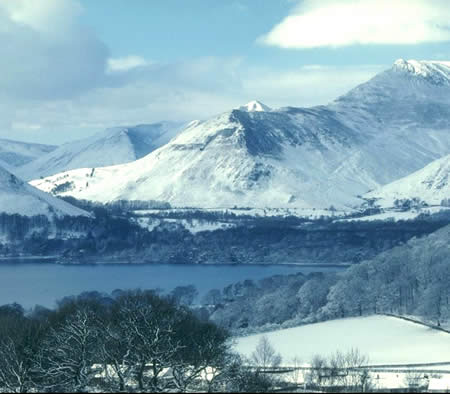
Larger version of Derwentwater photo (PDF)
This photo shows a wintry scene in Derwentwater and the Western Fells with Causey Pike looming to the right in the background. It looks across the lake from Falcon Crag, with mixed deciduous woodland in the foreground areas.
The Lake District's closeness to the sea means that it has milder winters and cooler summers than other northern areas of England. The sea warms up and cools down more slowly than the land as the seasons change, thus moderating the land temperatures. In the valleys of the Lake District there are about 20 days per year when snow falls, however this can increase to as much as 67 days per year on top of a mountain such as Helvellyn. The general rule to follow is that as the temperature falls by 1°C per 100m above sea level, the number of snow-covered days increases by about 5 per 100m. Keswick is the town situated at the north end of Derwentwater. It has an average daily temperature of 4.7°C in December which rises to 15°C in July.
Some general figures for average weather in the Lake District are 200 wet days per year and 145 dry days per year and 20 snowy days per year. However the weather on the fell tops will never be predictable and will always be ‘worse’ due to the relief rainfall caused by the height of the fells and the chill factor caused by the wind. Seathwaite in Borrowdale is England’s wettest inhabited place receiving around 3500mm of rainfall per year.
There is a local Weatherline forecast that people can use. We employ Fell Top Assessors to climb Helvellyn every day to record the weather conditions.
For walking and climbing in wintry conditions you need the correct clothing and equipment such as waterproofs, boots, ice axes, crampons, kisus (bivouac shelters), spare clothing, spare food and water. There are volunteer Mountain Rescue teams which are contacted through a rescue post or a 999 call to the police.
Hill sheep are able to withstand snow and cold but lowland sheep may have extra food put out for them. Cows are generally in barns between October and May because their pasture fields get waterlogged from the rain, the soil is eroded due to trampling, and the grass does not grow during winter. Moving them to barns enables them to be better fed (silage or hay and cattle cake) and protected from the worst of the weather.
Grid reference for Causey Pike: NY 218 208
deciduous, rainfall, mountain, hill, weather, climate
Would the lake freeze, how cold would it need to be?
Where are the animals, what would they be eating?
Why do some areas have more snow than others?
Where does the snow go when it melts?
How different would the weather be at the top of a mountain from the valley floor?
Where are the skiers? Compare Lake District snow with other mountain areas.
Discuss gear and equipment needed to enjoy winter walking and climbing.
Talk about the Mountain Rescue teams.
What do wild animals do in winter?
All links open in a new window: